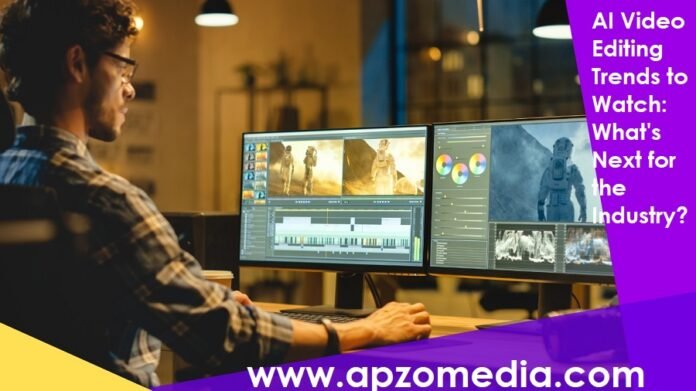The world of video editing has evolved significantly over the years, and artificial intelligence (AI) has played a pivotal role in this transformation. AI-powered video editing tools have revolutionized the way content creators, filmmakers, and video editors approach their craft. As technology continues to advance, it’s essential to keep an eye on the latest trends shaping the AI video editing industry. In this blog, we’ll explore some of the most exciting AI video editing trends to watch and what they mean for the future of visual storytelling.
1. Automated Video Editing:
Automated video editing is one of the most transformative trends in the industry. AI algorithms can analyze raw footage and automatically generate edited sequences, saving editors significant time and effort. As this technology improves, we can expect to see more content creators using automated editing tools to streamline their workflows.
The benefits of using an AI video editor is clear: faster turnaround times, reduced labor costs, and increased efficiency. However, content creators will still need to fine-tune and add their creative touch to ensure the final product meets their vision.
2. AI-Enhanced Storytelling:
AI is increasingly being used to enhance storytelling in videos. Natural language processing (NLP) algorithms can analyze scripts and suggest improvements to make narratives more engaging and compelling. This trend is particularly relevant for filmmakers and content creators looking to create emotionally resonant stories.
Additionally, AI can help with scene analysis and content tagging, making it easier to search for specific scenes or themes within large video libraries. This not only improves efficiency but also opens up new possibilities for creative storytelling.
3. Realistic Deepfake Effects:
Deepfake technology has garnered attention for its potential to create highly convincing fake videos. While ethical concerns abound, this technology can also be harnessed for creative and entertainment purposes. AI-driven deepfake effects can help filmmakers and video editors create stunning visual effects and transform actors’ appearances in a way that was previously challenging and costly.
As AI algorithms become more sophisticated, we can expect to see a broader range of applications for deepfake effects in the film and entertainment industry. However, ethical considerations and guidelines will be essential to ensure responsible use.
4. Smart Content Personalization:
AI is making it easier to personalize video content for different audiences. By analyzing viewer data and preferences, AI algorithms can suggest content modifications in real time. This can range from adjusting the video’s length to changing the order of scenes or even tailoring the content to different demographics.
Smart content personalization not only enhances the viewing experience but also helps content creators target their audience more effectively. As this trend evolves, we can anticipate more personalized and engaging video content.
5. AI-Driven Color Grading and Visual Effects:
Color grading and visual effects are critical aspects of video post-production. AI-powered tools can analyze the visual content of a video and suggest color grading options that match the desired mood or style. This technology can significantly speed up the color grading process and improve overall video quality.
In addition to color grading, AI is also being used to enhance visual effects. AI algorithms can identify and track objects within a video, making it easier to add realistic visual effects seamlessly. This trend is particularly relevant in the film industry, where high-quality visual effects are essential for storytelling.
6. Improved Video Accessibility:
AI-driven tools are helping to make videos more accessible to individuals with disabilities. Automatic captioning and audio description tools powered by AI can generate accurate captions and describe visual elements, making videos more inclusive.
This trend aligns with the growing importance of accessibility in media and entertainment. As regulations and standards continue to evolve, AI will play a vital role in ensuring that video content is accessible to a broader audience.
7. Enhanced Video Analytics:
AI is revolutionizing video analytics by providing deeper insights into viewer behavior. Content creators can use AI to track viewer engagement, monitor drop-off points, and gather data on viewer preferences. This information is invaluable for refining content strategies and optimizing video content for better performance.
By harnessing AI-driven video analytics, businesses and content creators can make data-driven decisions that lead to more effective video marketing and content development strategies.
8. AI-Generated Music and Soundscapes:
AI is not limited to video visuals; it’s also making its mark on audio production. AI algorithms can generate original music and soundscapes tailored to the mood and style of a video. This eliminates the need for expensive music licenses and opens up creative possibilities for video creators.
AI-generated music is becoming more sophisticated and can rival human compositions in quality. This trend will likely lead to more affordable and customized audio options for video creators.
The Bottom Line:
The AI video editing industry is at the forefront of innovation in visual storytelling. As technology continues to advance, we can expect to see even more exciting developments in automated editing, storytelling enhancement, deepfake effects, personalization, color grading, accessibility, analytics, and audio production.
Content creators, filmmakers, and video editors who embrace these AI video editing trends will gain a competitive edge in the ever-evolving media landscape. It’s an exciting time for the industry, with AI unlocking new possibilities and efficiencies in video production and storytelling. As these trends continue to shape the future of video editing, we can look forward to more creative and impactful visual content.
Read Also: A Guide to Mac Video Maker: How to Make Great Videos on a Mac



































































